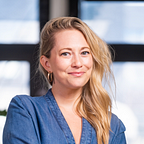Making Space for Creativity
Salons of the 1800s hosted some of the greatest minds in art, literature, and politics. Where can we have those conversations IRL today?
You know that thing they say about “when you’re the smartest person in the room, you’re in the wrong room?” Well, we tried to remedy that last week by co-hosting the first Creative Factor Salon and we all walked away a little smarter.
The Parisian salons of the 1700 and 1800s were organized by folks (including many women) in their private homes (salon means “living room” in French) and these meetings served as an approved place to discuss literature, politics, and art (since they couldn’t very well do this out in the open. Scandal.)
They paint a picture of a more romantic era — one where the whole idea for the party was discussing difficult topics and sharing opinions. Over wine. Of course.
No time machine here, but we like the concept. And through The Creative Factor–a destination devoted to highlighting stories from creative individuals–we had a network of bright minds we wanted to bring together, mainly to see what kinds of magic might happen.
So we invited activists and artists, landscape designers and NFT storytellers, immersive event builders and architects, TV executives and painters. And here’s what we learned:
Titles are meaningless but name tags never go out of style.
We made a point to individually introduce everyone in the room–not by their titles–but by what they love to do. Of course this is only possible if you intimately know the people at your gathering, which we did. But now they know each other. Not by some impersonal label bestowed by the C-suite but by how close friends might brag about them over dinner. It makes a difference. We are not the summation of our promotions. We are the work.
On the other side: Name tags are a bit old-fashioned, but they’re really good at their one job: Helping human brains attempt to remember something they are keen to forget.
AI-generated art is here to change everything.
Our Creative Director Alex Severino presented some of his takeaways around the strengths and shortcomings of the newest AI-generated art tools, namely Dall-E 2 (it’s free to signup and they’ll give you 50 credits off the bat to start making your own, creepy art. Hey, maybe you’ll win an art competition).
Many are worried these tools will disrupt creative industires in a big way.
We tried to look at it from a process point of view: How will the AI tools change the way we think about creativity? How will they save us time (especially with our Coalesce space pigeon art)?
Then we asked the crowd to co-create an imaginary book cover for a new novel about burnout. The prompt? “A sculpture of an angsty piece of toast in Utopia, art deco, award winning art, 8k, high resolution with the word “Matt” burned into toast.”
Shortcomings:
- The AI isn’t good with counting (and therefore never guesses the appropriate amount of teeth).
- The AI struggles with realistic representation of living things (humans often have strange eyes and cats might have too many limbs).
- The AI doesn’t understand irrational contrast in scale (eg. putting stairs on a chair).
- The user has no awareness of which artists Dall-E is referencing (there are no sources cited).
Wins:
- The The AI is great at scene development.
- Dall-E’s Inpainting feature is a game changer (you can snip out a part of the image to replace).
- Referencing style across mediums produces inspiring results (try mixing architectural style with a famous fashion designer, for example).
- Uploading images to generate variations could change the nature of inspiration (creating variations based on your own artwork is pretty rad).
This the conversation continued around how these super-powerful AI tools are going to impact graphic design jobs, how do we define ownership, and what’s ethical in terms of representation.
Either way, the change is irreversible. How we handle it is what will define the next decade of work. (If we can rely on each other, we’ll probably be able to tackle whatever the robots throw our way.)
We might be our most creative when we feel at home.
The one thing those salons of yesteryear all shared were that they were hosted in someone’s home (and often named after the room in which they were held). The bonus of our event space (the top floor of our Coalesce HQ) is that it is in fact a converted studio space that used to be a living quarters.
As we’ve all learned to adjust to working from home these past few years, the work place has a completely different purpose now. And even though collaborating is sometimes easier in a formal conference room, a living room is inherently more comfortable, more intimate, and more relaxed.
I’m not sure if those are reliable ingredients for creative conversation, but they sure seem to make people open up. Maybe the salon, I mean, the living room, has more power than we thought.
Stay tuned for the next Creative Factor Salon early 2023.
And if you’re in the mood to discuss your product strategy, your brand, or your AI art, you can find us at hello@coalesce.nyc.
